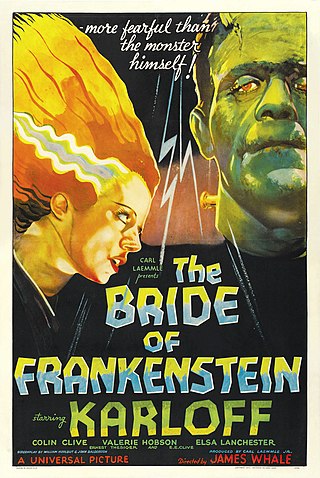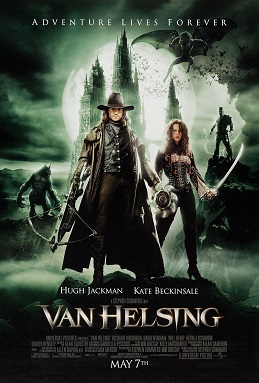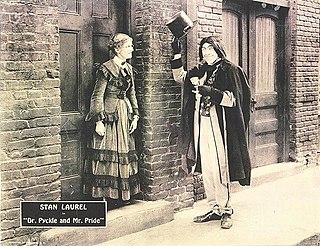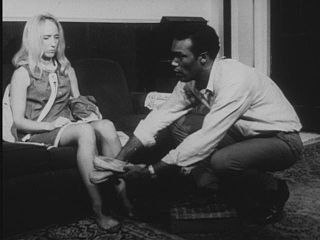
Bride of Frankenstein is a 1935 American science fiction horror film, and the first sequel to Universal Pictures' 1931 film Frankenstein. As with the first film, Bride of Frankenstein was directed by James Whale starring Boris Karloff as the Monster and Colin Clive as Dr. Frankenstein. The sequel features Elsa Lanchester in the dual role of Mary Shelley and the bride. Colin Clive reprises his role as Henry Frankenstein, and Ernest Thesiger plays the role of Doctor Septimus Pretorius. Oliver Peters Heggie plays the role of the old blind hermit.
Hammer Film Productions Ltd. is a British film production company based in London. Founded in 1934, the company is best known for a series of Gothic horror and fantasy films made from the mid-1950s until the 1970s. Many of these involve classic horror characters such as Baron Victor Frankenstein, Count Dracula, and the Mummy, which Hammer reintroduced to audiences by filming them in vivid colour for the first time. Hammer also produced science fiction, thrillers, film noir and comedies, as well as, in later years, television series.

Dr. Henry Jekyll and his alter ego, Mr. Edward Hyde, is the central character of Robert Louis Stevenson's 1886 novella Strange Case of Dr Jekyll and Mr Hyde. In the story, he is a good friend of main protagonist Gabriel John Utterson.

Young Frankenstein is a 1974 American comedy horror film directed by Mel Brooks. The screenplay was co-written by Brooks and Gene Wilder. Wilder also starred in the lead role as the title character, a descendant of the infamous Dr. Victor Frankenstein. Peter Boyle portrayed the monster. The film co-stars Teri Garr, Cloris Leachman, Marty Feldman, Madeline Kahn, Kenneth Mars, Richard Haydn, and Gene Hackman.

Van Helsing is a 2004 action horror film written and directed by Stephen Sommers. It stars Hugh Jackman as monster hunter Van Helsing and Kate Beckinsale as Anna Valerious. Van Helsing is both an homage and tribute to the Universal Horror Monster films from the 1930s and 1940s, of which Sommers is a fan.

Frankenstein's Daughter is an independently made 1958 American black-and-white science fiction/horror film drama, produced by Marc Frederic and George Fowley, directed by Richard E. Cunha, that stars John Ashley, Sandra Knight, Donald Murphy, and Sally Todd. The film was distributed by Astor Pictures and was released theatrically as a double feature with Missile to the Moon.

Alvin and the Chipmunks Meet the Wolfman is a 2000 American animated comedy horror musical film produced by Bagdasarian Productions and Universal Cartoon Studios and based on characters from Alvin and the Chipmunks. It is the second Alvin and the Chipmunks direct-to-video film following Alvin and the Chipmunks Meet Frankenstein, and the third of three Universal Cartoon Studios productions to be animated overseas by Tama Productions in Tokyo, Japan. The film introduces the voices of Maurice LaMarche and Miriam Flynn.

The Universal Monsters media franchise includes characters based on a series of horror films produced by Universal Pictures and released between 1913–1956.

Mary Shelley's 1818 novel Frankenstein; or, The Modern Prometheus, and the famous character of Frankenstein's monster, have influenced popular culture for at least a century. The work has inspired numerous films, television programs, video games and derivative works. The character of the Monster remains one of the most recognized icons in horror fiction.

Blackenstein is a 1973 American blaxploitation horror film directed by William A. Levey, and starring John Hart, Ivory Stone, Andrea King, Roosevelt Jackson, Joe De Sue, Nick Bolin and Liz Renay. It is loosely based on Mary Shelley's 1818 novel Frankenstein; or, The Modern Prometheus. Released on August 3, 1973, it was made in an attempt to cash in on the success of Blacula; released the previous year by American International Pictures. However, Blackenstein fared poorly in comparison to its predecessor, with most reviews agreeing that the film was "a totally inept mixture of the worst horror and blaxploitation films".

Mad Monster Party? is a 1967 stop-motion animated musical comedy film produced by Rankin/Bass Productions for Embassy Pictures. The film stars the voices of Boris Karloff, Allen Swift, Gale Garnett, and Phyllis Diller. It tells the story of a mad scientist who achieves the secret of total destruction as he summons all the monsters to his island home to show it off while planning to retire as the head of the "Worldwide Organization of Monsters".

Dr. Pyckle and Mr. Pryde is a 1925 American silent, black-and-white comedy horror film, directed by Scott Pembroke and Joe Rock.

Blaxploitation is an ethnic subgenre of the exploitation film that emerged in the United States during the early 1970s, when the combined momentum of the civil rights movement, the black power movement, and the Black Panthers spurred African-American artists to reclaim the power of depiction of their ethnicity, and institutions like UCLA to provide financial assistance for African-American students to study filmmaking. This combined with Hollywood adopting a less restrictive rating system in 1968. The term, a portmanteau of the words "black" and "exploitation", was coined in August 1972 by Junius Griffin, the president of the Beverly Hills–Hollywood NAACP branch. He claimed the genre was "proliferating offenses" to the black community in its perpetuation of stereotypes often involved in crime. After the race films of the 1940s and 1960s, the genre emerged as one of the first in which black characters and communities were protagonists, rather than sidekicks, supportive characters, or victims of brutality. The genre's inception coincides with the rethinking of race relations in the 1970s.

Son of Ingagi is a 1940 American black horror monster movie directed by Richard C. Kahn. It was the first science fiction horror film to feature an all-black cast. It was written by Spencer Williams based on his own short story, House of Horror. Although the film's title appears to suggest that it is a sequel to the 1930 movie Ingagi, it is not.

Strange Case of Dr Jekyll and Mr Hyde is an 1886 novella written by the Scottish author Robert Louis Stevenson. It is about a London lawyer, Gabriel John Utterson, who investigates strange occurrences between his old friend, Dr. Henry Jekyll and the misanthropic Mr. Hyde. In a twist ending, it is revealed that Jekyll and Hyde were the same person, and that Jekyll had regularly transformed himself into Hyde by drinking a serum.

Monster literature is a genre of literature that combines good and evil and intends to evoke a sensation of horror and terror in its readers by presenting the evil side in the form of a monster.
Blaxploitation horror films are a genre of horror films involving mostly black actors. In 1972, William Crain directed what is considered to be the first blaxploitation horror film, Blacula.

The representation of gender in horror films, particularly depictions of women, has been the subject of critical commentary.

Depictions of race in horror films have been the subject of commentary by fans and academics. Critics have discussed the representation of race in horror films in relation to the presence of racist ideas, stereotypes and tropes within them. The horror genre has conversely also been used to explore social issues including race, particularly following popularization of social thrillers in the 2010s.

The history of horror films was described by author Siegbert Solomon Prawer as difficult to read as a linear historical path, with the genre changing throughout the decades, based on the state of cinema, audience tastes and contemporary world events.


















